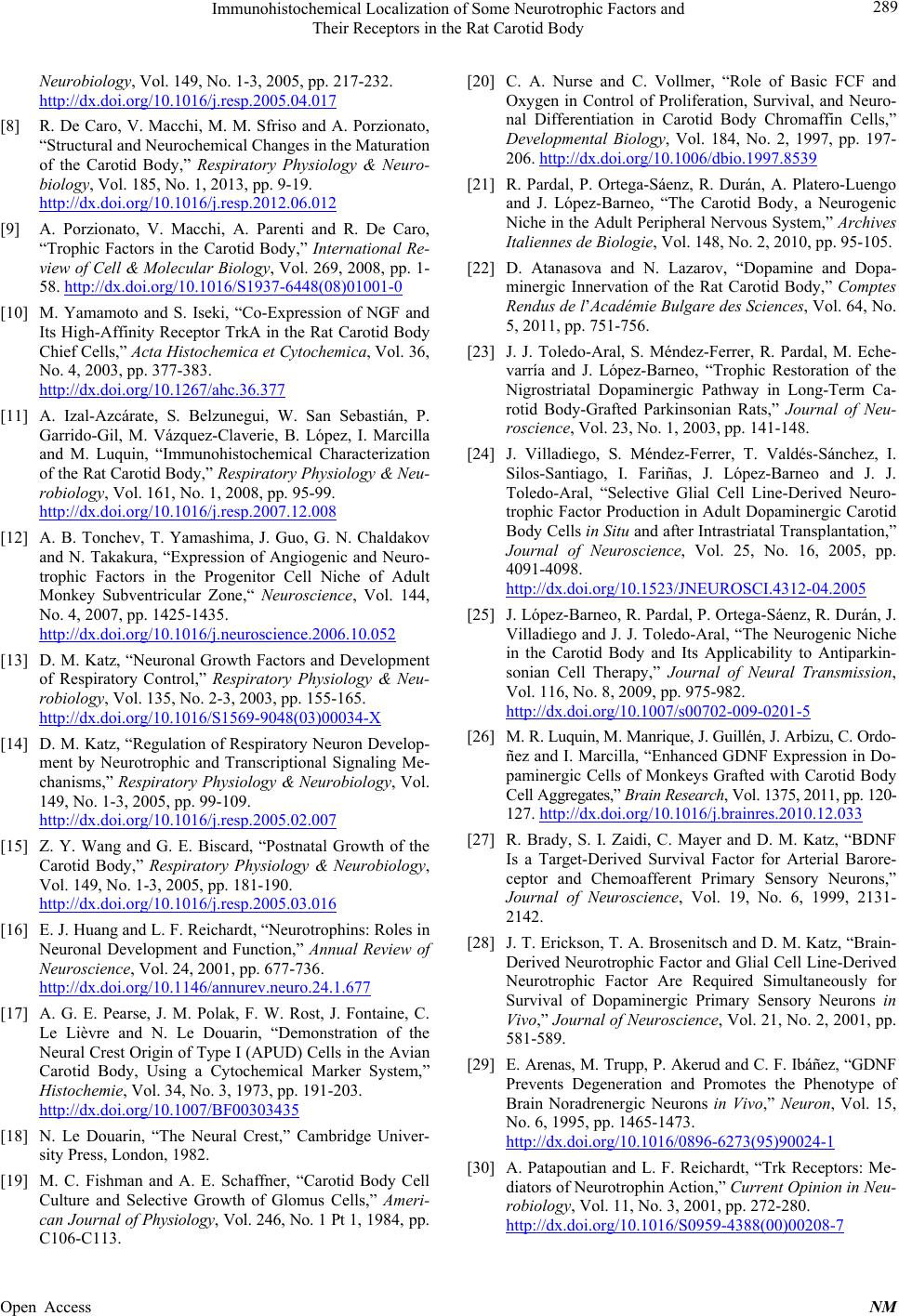
Immunohistochemical Localization of Some Neurotrophic Factors and
Their Receptors in the Rat Carotid Body
Open Access NM
289
Neurobiology, Vol. 149, No. 1-3, 2005, pp. 217-232.
http://dx.doi.org/10.1016/j.resp.2005.04.017
[8] R. De Caro, V. Macchi, M. M. Sfriso and A. Porzionato,
“Structural and Neurochemical Changes in the Maturation
of the Carotid Body,” Respiratory Physiology & Neuro-
biology, Vol. 185, No. 1, 2013, pp. 9-19.
http://dx.doi.org/10.1016/j.resp.2012.06.012
[9] A. Porzionato, V. Macchi, A. Parenti and R. De Caro,
“Trophic Factors in the Carotid Body,” International Re-
view of Cell & Molecular Biology, Vol. 269, 2008, pp. 1-
58. http://dx.doi.org/10.1016/S1937-6448(08)01001-0
[10] M. Yamamoto and S. Iseki, “Co-Expression of NGF and
Its High-Affinity Receptor TrkA in the Rat Carotid Body
Chief Cells,” Acta Histochemica et Cytochemica, Vol. 36,
No. 4, 2003, pp. 377-383.
http://dx.doi.org/10.1267/ahc.36.377
[11] A. Izal-Azcárate, S. Belzunegui, W. San Sebastián, P.
Garrido-Gil, M. Vázquez-Claverie, B. López, I. Marcilla
and M. Luquin, “Immunohistochemical Characterization
of the Rat Carotid Body,” Respiratory Physiology & Neu-
robiology, Vol. 161, No. 1, 2008, pp. 95-99.
http://dx.doi.org/10.1016/j.resp.2007.12.008
[12] A. B. Tonchev, T. Yamashima, J. Guo, G. N. Chaldakov
and N. Takakura, “Expression of Angiogenic and Neuro-
trophic Factors in the Progenitor Cell Niche of Adult
Monkey Subventricular Zone,“ Neuroscience, Vol. 144,
No. 4, 2007, pp. 1425-1435.
http://dx.doi.org/10.1016/j.neuroscience.2006.10.052
[13] D. M. Katz, “Neuronal Growth Factors and Development
of Respiratory Control,” Respiratory Physiology & Neu-
robiology, Vol. 135, No. 2-3, 2003, pp. 155-165.
http://dx.doi.org/10.1016/S1569-9048(03)00034-X
[14] D. M. Katz, “Regulation of Respiratory Neuron Develop-
ment by Neurotrophic and Transcriptional Signaling Me-
chanisms,” Respiratory Physiology & Neurobiology, Vol.
149, No. 1-3, 2005, pp. 99-109.
http://dx.doi.org/10.1016/j.resp.2005.02.007
[15] Z. Y. Wang and G. E. Biscard, “Postnatal Growth of the
Carotid Body,” Respiratory Physiology & Neurobiology,
Vol. 149, No. 1-3, 2005, pp. 181-190.
http://dx.doi.org/10.1016/j.resp.2005.03.016
[16] E. J. Huang and L. F. Reichardt, “Neurotrophins: Roles in
Neuronal Development and Function,” Annual Review of
Neuroscience, Vol. 24, 2001, pp. 677-736.
http://dx.doi.org/10.1146/annurev.neuro.24.1.677
[17] A. G. E. Pearse, J. M. Polak, F. W. Rost, J. Fontaine, C.
Le Lièvre and N. Le Douarin, “Demonstration of the
Neural Crest Origin of Type I (APUD) Cells in the Avian
Carotid Body, Using a Cytochemical Marker System,”
Histochemie, Vol. 34, No. 3, 1973, pp. 191-203.
http://dx.doi.org/10.1007/BF00303435
[18] N. Le Douarin, “The Neural Crest,” Cambridge Univer-
sity Press, London, 1982.
[19] M. C. Fishman and A. E. Schaffner, “Carotid Body Cell
Culture and Selective Growth of Glomus Cells,” Ameri-
can Journal of Physiology, Vol. 246, No. 1 Pt 1, 1984, pp.
C106-C113.
[20] C. A. Nurse and C. Vollmer, “Role of Basic FCF and
Oxygen in Control of Proliferation, Survival, and Neuro-
nal Differentiation in Carotid Body Chromaffin Cells,”
Developmental Biology, Vol. 184, No. 2, 1997, pp. 197-
206. http://dx.doi.org/10.1006/dbio.1997.8539
[21] R. Pardal, P. Ortega-Sáenz, R. Durán, A. Platero-Luengo
and J. López-Barneo, “The Carotid Body, a Neurogenic
Niche in the Adult Peripheral Nervous System,” Archives
Italiennes de Biologie, Vol. 148, No. 2, 2010, pp. 95-105.
[22] D. Atanasova and N. Lazarov, “Dopamine and Dopa-
minergic Innervation of the Rat Carotid Body,” Comptes
Rendus de l’Académie Bulgare des Sciences, Vol. 64, No.
5, 2011, pp. 751-756.
[23] J. J. Toledo-Aral, S. Méndez-Ferrer, R. Pardal, M. Eche-
varría and J. López-Barneo, “Trophic Restoration of the
Nigrostriatal Dopaminergic Pathway in Long-Term Ca-
rotid Body-Grafted Parkinsonian Rats,” Journal of Neu-
roscience, Vol. 23, No. 1, 2003, pp. 141-148.
[24] J. Villadiego, S. Méndez-Ferrer, T. Valdés-Sánchez, I.
Silos-Santiago, I. Fariñas, J. López-Barneo and J. J.
Toledo-Aral, “Selective Glial Cell Line-Derived Neuro-
trophic Factor Production in Adult Dopaminergic Carotid
Body Cells in Situ and after Intrastriatal Transplantation,”
Journal of Neuroscience, Vol. 25, No. 16, 2005, pp.
4091-4098.
http://dx.doi.org/10.1523/JNEUROSCI.4312-04.2005
[25] J. López-Barneo, R. Pardal, P. Ortega-Sáenz, R. Durán, J.
Villadiego and J. J. Toledo-Aral, “The Neurogenic Niche
in the Carotid Body and Its Applicability to Antiparkin-
sonian Cell Therapy,” Journal of Neural Transmission,
Vol. 116, No. 8, 2009, pp. 975-982.
http://dx.doi.org/10.1007/s00702-009-0201-5
[26] M. R. Luquin, M. Manrique, J. Guillén, J. Arbizu, C. Ordo-
ñez and I. Marcilla, “Enhanced GDNF Expression in Do-
paminergic Cells of Monkeys Grafted with Carotid Body
Cell Aggregates,” Brain Research, Vol. 1375, 2011, pp. 120-
127. http://dx.doi.org/10.1016/j.brainres.2010.12.033
[27] R. Brady, S. I. Zaidi, C. Mayer and D. M. Katz, “BDNF
Is a Target-Derived Survival Factor for Arterial Barore-
ceptor and Chemoafferent Primary Sensory Neurons,”
Journal of Neuroscience, Vol. 19, No. 6, 1999, 2131-
2142.
[28] J. T. Erickson, T. A. Brosenitsch and D. M. Katz, “Brain-
Derived Neurotrophic Factor and Glial Cell Line-Derived
Neurotrophic Factor Are Required Simultaneously for
Survival of Dopaminergic Primary Sensory Neurons in
Vivo,” Journal of Neuroscience, Vol. 21, No. 2, 2001, pp.
581-589.
[29] E. Arenas, M. Trupp, P. Akerud and C. F. Ibáñez, “GDNF
Prevents Degeneration and Promotes the Phenotype of
Brain Noradrenergic Neurons in Vivo,” Neuron, Vol. 15,
No. 6, 1995, pp. 1465-1473.
http://dx.doi.org/10.1016/0896-6273(95)90024-1
[30] A. Patapoutian and L. F. Reichardt, “Trk Receptors: Me-
diators of Neurotrophin Action,” Current Opinion in Neu-
robiology, Vol. 11, No. 3, 2001, pp. 272-280.
http://dx.doi.org/10.1016/S0959-4388(00)00208-7